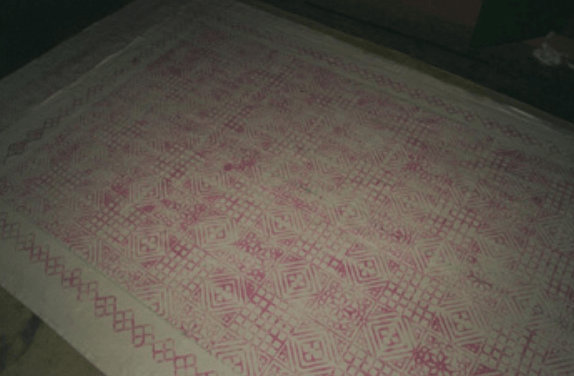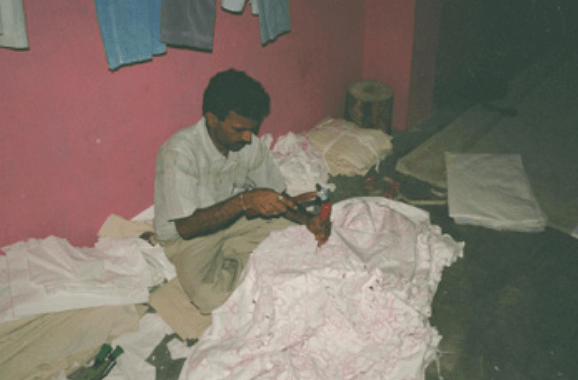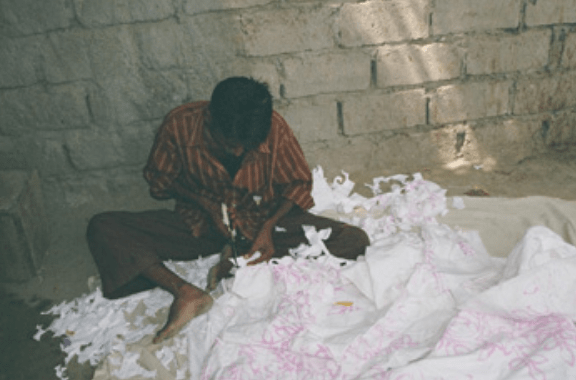Patchwork and appliqué are very ancient techniques and sometimes referred to as one. The only difference between them is that patchwork or piecework is the process of seaming small pieces of fabric in to a larger whole, while appliqué is the process of sewing smaller pieces of fabric onto a larger background fabric. It is a technique of forming a single pattern with different pieces of cloth. Pieces of fabric are applied on top of another for decorative or functional purposes.
History
Appliqué is an ancient technique of creating beautiful and decorative items with different pieces of cloth. Nomadic people of the desert have long pieced together their tents and even decorated them with elaborate appliqué. Festive patchwork textiles created for special occasions are found in many places throughout India. Pieced and appliquéd household items are made by women for dowries. These objects include decorative bags, pillows and sitting mats. Appliqué played a part in religious textiles as well. It has long been used to make decorative clothing, because most clothing is used until it is worn out and then again re used to create beautiful patterns out of the worn fabric. This serves both economic and decorative purposes. Small pieces of fabric are cut and joined side by side to make a large piece of fabric or for repairing a damaged fabric. The craft seems to have been prevalent all over India.
“ In all periods there are to be found in pieced quilts both unique and conventional designs; within the framework of the latter each maker had full liberty in terms of colors, arrangements, sizes of the blocks and her own variations. So no two are ever alike; each reflects the sensibilities and visual skills of its maker”- Jonathan Holstein
Regions Patchwork and appliqué are done in many different geographical regions of India with each area having its own particular local aesthetic. The main centers where the crafts are practiced are:
•Rajasthan: Barmer, Jodhpur, Ranthambore and Jaisalmer
•Gujarat: Kutch
•Bihar
•Himachal Pradesh: Kangra and Chamba
•Karnataka
•Orissa: Pipli
Each of these regions used their distinct styles and colour palettes to create decorative designs. These old patterns can be found in museums; there are a few pieces that are still remaining with the craftspeople. They still use traditional motifs and unique colour schemes when making products for their own use.
Producer Communities
Throughout Kutch and Kathiawar regions of Gujarat many tribes practice appliqué-embroidered work. Mutva, Hingorjah and Harijan (to name but three) are expert appliqué workers. In Orissa this craft was traditionally practiced by professional tailors know as ‘Darjis’, but nowadays various other castes have also taken it up. In Rajasthan the main communities practicing this craft are Rajput, Yadav, Acharya, Muslim, Lohar and Soni.
Raw material
The basic material for appliqué is cloth. Cotton cloth, which was being used traditionally, continues to be used today. Voile is also used to give it a more classy and delicate look.
Multi colored threads as well as fabric swatches are required as per the design.
Tools
Needle, a pair of scissors.
Process
Appliqué, which is a French term, is a technique of forming a single pattern with different pieces of cloth. Pieces of fabric are applied on top of another for decorative or functional purposes.
Design:
Most appliqué designs are shown as full-size drawings for the completed design. The drawings show dotted lines to indicate where one piece overlaps another. Other marks indicate placement of embroidery stitches for decorative purposes, marking such features as eyes, lips, flowers, trees etc.
Before the actual appliqué process begins, the background block is cut and prepared for stitching. Sometimes the background fabric is prepared by joining various shaped fabric swatches (squares, rectangles, various geometric shapes etc) and then on top of this base the appliqué work is done. Most appliqué designs are centered on the block. To find the center of the background square, it is folded in half and in half again; and then creased with fingers. It is then unfolded and the process repeated along the diagonals.
Tracing:
An actual-sized drawing of the design is transferred on to a large piece of tracing paper. Tracing paper is placed on top of the design and the design is traced out. Holes are pierced on the tracing paper along the design and water erasable ink is used along the dotted line to transfer the design on to the fabric.
Pasting:
Fabric is placed on to the background fabric and stuck with glue (called ‘lai’ in the local language, it is made out of wheat flour, gum and water).
Cutting of shapes / design:
Once the fabric is prepared and the required design is traced on it, 1/2” space is left between design motifs to allow for the seam when cutting out the shapes. The shapes are cut out leaving 1/8”- 1/4″ all around the drawn line for turning under.
Tidying:
The shaped edges are turned over on the drawn or stitched line. Corners are made sharp and edges smoothened. The fabric patch should retain the shape of the template used to cut it.
Stitching:
Then using a blind stitch or appliqué stitch, the cut fabric is sown with matching thread on to the background fabric. The stitching is started with the background pieces first, working up to foreground pieces.
Finishing:
The product is given final finishing touches. Any extra threads are cut, and edges smoothened.
As per the design required, different colors of fabric are used. Sometimes the cuttings are in contrast to the base fabric. Sometimes the same color is used for base and pattern, as in white on white, which is very much in current demand.
Market
Patchwork and appliqué wall hangings, bedspreads, tablecloths, cushion covers; bolster covers and quilts have become quite popular in the urban market. Demand for appliqué work has increased over the last decade. The work is functional and decorative at the same time. Patchwork designs are timeless; they grace any setting – traditional, modern or Art Deco.
Most of the patchwork products are produced in bulk for the international and domestic markets. For the international market exporters use more contemporary designs (usually geometric patterns) and pastel colours (favorites are white on white, or cream on white). Similar trends are seen in the domestic market as far as urban consumers are concerned. Designs like trees, birds, and animal motifs are also popular in the domestic market.
Appliqué does face competition in the market just as other hand printed and handmade fabrics do because of the price and the time involved in producing them in bulk.








